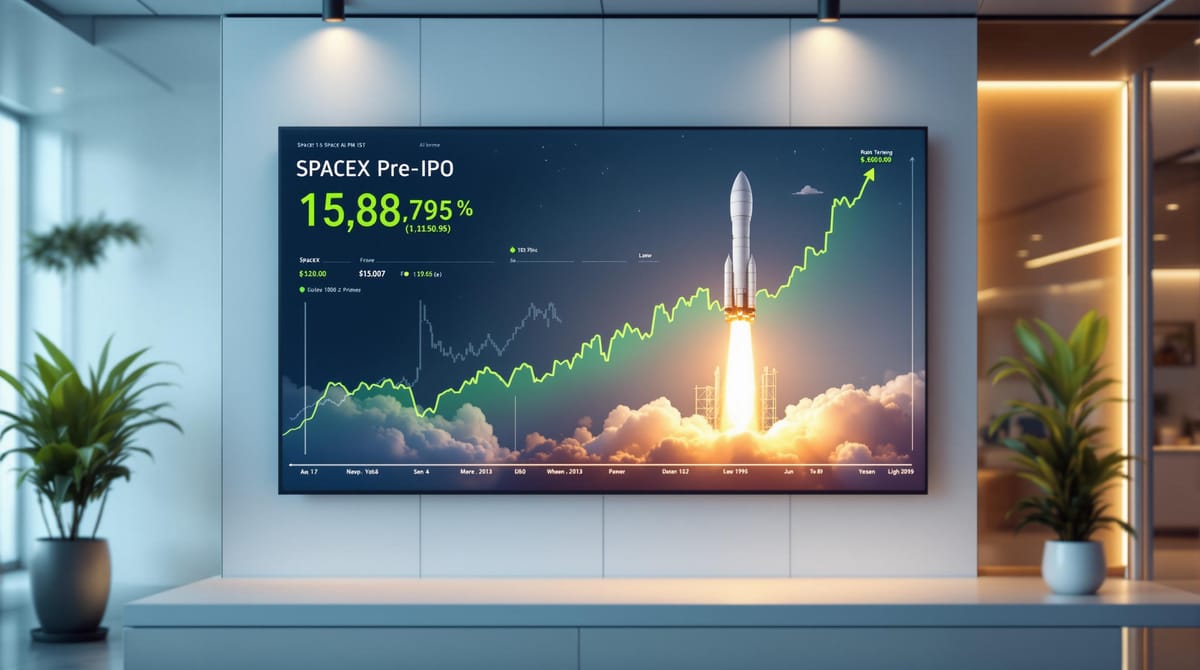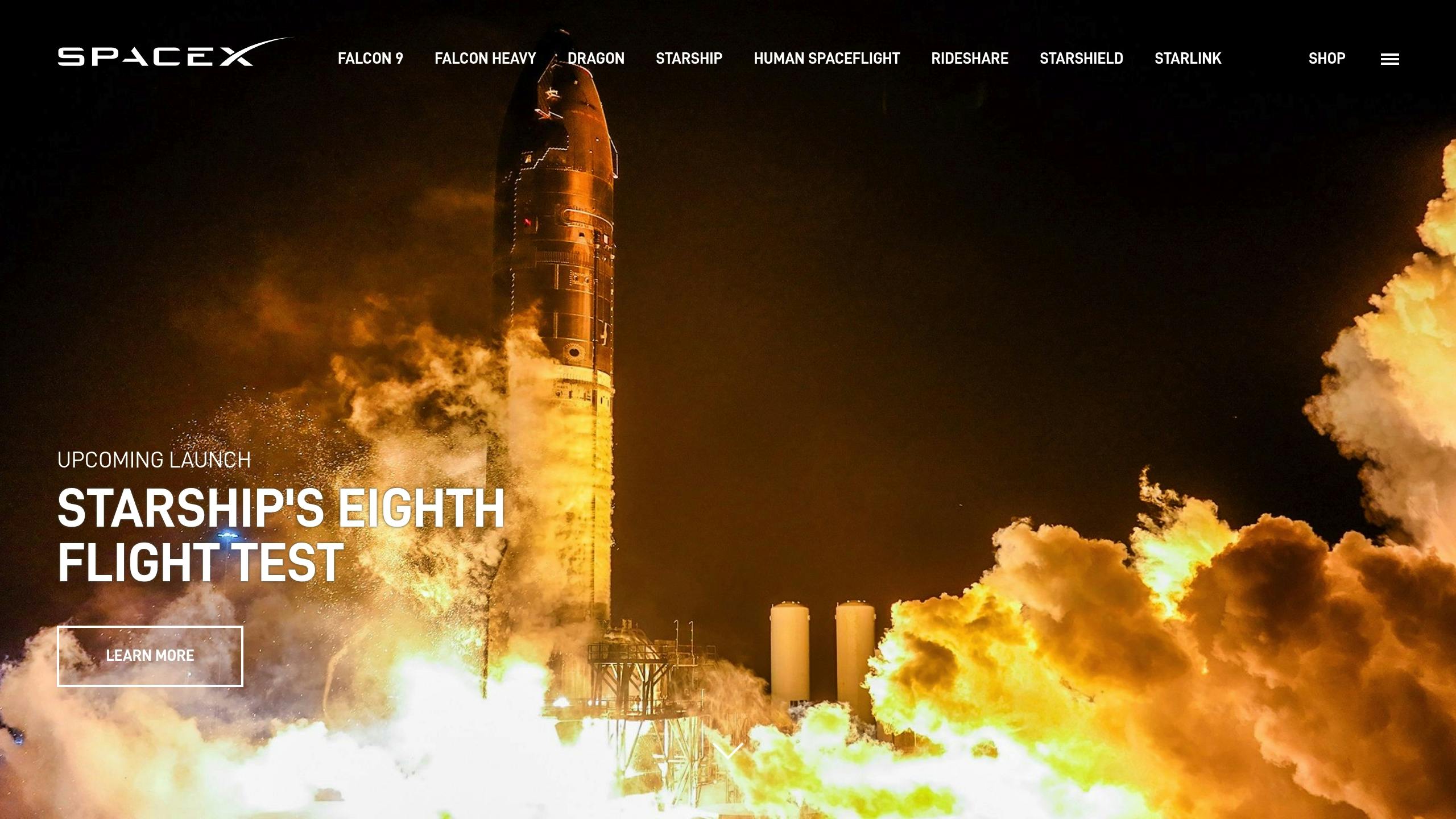SpaceX Stock Pricing Trends In Secondary Markets
Explore SpaceX's soaring pre-IPO stock prices and valuation trends in secondary markets, alongside investment insights and platform comparisons.

SpaceX's pre-IPO stock is surging in secondary markets, with significant growth in valuations and share prices. Here's what you need to know:
- Current Valuation: SpaceX's valuation on Forge Global reached $447.64 billion as of March 2025.
- Stock Price Growth: Shares climbed from $87.08 (Jan 2024) to $213.39 (Jan 2025), marking a 145% increase in one year.
- Platform Discrepancies: Valuations vary across platforms: Forge Global lists SpaceX at $236.61/share, while UpMarket estimates a different price.
- Challenges: Secondary markets face hurdles like 2–10% fees, limited liquidity, and SpaceX's Right of First Refusal (ROFR).
Quick Comparison of Investment Platforms
| Platform | Stock Price (Mar 2025) | Liquidity | Fees |
|---|---|---|---|
| Forge Global | $236.61 | Low | 2–10% |
| Hiive | Not disclosed | Moderate | Varies |
| UpMarket | Not disclosed | Low | Unknown |
| EquityZen | Not disclosed | Low | High |
Key Takeaway: SpaceX's stock is a hot commodity, but navigating secondary markets requires careful consideration of fees, liquidity, and valuation inconsistencies.
The Ultimate Guide to Investing in SpaceX

1. Secondary Market Price Analysis
SpaceX's stock price showed consistent growth throughout 2024 and into early 2025. Here's a breakdown of the company's quarterly stock price performance in 2024:
| Quarter | Stock Price | % Change |
|---|---|---|
| 2024 Q1 | $101.85 | - |
| 2024 Q2 | $109.51 | +7.52% |
| 2024 Q3 | $117.95 | +7.71% |
| 2024 Q4 | $199.04 | +68.74% |
These gains highlight the varied valuations seen across platforms as of March 1, 2025. For instance, Forge Global listed SpaceX at $236.61 per share, while Notice.co reported a lower $183.46 per share. This gap underscores the challenges of private market valuations and the different methods used to calculate them.
In December 2024, SpaceX's valuation jumped to $350 billion during a secondary share sale. The company and investors reached a $1.25 billion deal at $185 per share. Elon Musk commented:
"almost no investors wanted to sell shares" at the new $350 billion valuation
While the stock saw a -10.86% decline year to date, it still posted a 12.25% overall increase over the past 12 years. These valuation differences provide insight into market premiums and trading activity.
Looking at market trends, here's how valuation premiums have evolved:
| Year | Base Valuation | Market Cap | Premium |
|---|---|---|---|
| 2023 | $137.00B | $152.14B | +11% |
| 2024 | $137.00B | $373.19B | +172% |
| 2025 | $137.00B | $343.98B | +151% |
Trading activity stabilized by August 2023. However, platforms like Forge Global, EquityZen, Hiive, and UpMarket continue to restrict access to accredited investors. Among these, UpMarket offers some better liquidity options.
2. SpaceX Stock Investment Guide Review
Building on earlier market analysis, the SpaceX Stock Investment Guide dives into secondary market opportunities for SpaceX, focusing on valuation trends and strategies for managing risks. The guide highlights that investments in space technology have delivered returns of 12–15% above market averages since 2020.
One standout feature of the guide is its detailed comparison of investment requirements across different platforms:
| Platform Type | Minimum Investment | Average Returns | Liquidity |
|---|---|---|---|
| Secondary Markets | $100,000+ | 15–25% | Low |
| SPVs | $25,000+ | 20–30% | Very Low |
| VC Platforms | $1,000+ | 25–35% | None |
This breakdown highlights how investment thresholds, returns, and liquidity vary depending on the platform.
The guide also points out that SpaceX supply chain companies have outperformed the S&P 500 by 23% since 2020, while businesses supporting Starlink exceeded tech indices by 18% in 2023. These results provide context for the guide’s risk management advice.
For managing risk, the guide suggests keeping alternative investments to 5–10% of an overall portfolio and spreading investments across multiple vehicles. It also notes that platforms like UpMarket and Forge Global require a minimum investment of $100,000.
Additionally, the guide reviews space-focused ETFs, which collectively raised over $800 million in 2023, offering a broader perspective on SpaceX's role within the larger space industry.
Platform Comparison
Let’s take a closer look at how major platforms for SpaceX stock differ in terms of accessibility, cost, and trading requirements.
Secondary market platforms like Forge Global, EquityZen, Hiive, and Upmarket each come with their own set of features and limitations. For instance, Forge listed SpaceX stock at $236.61 as of March 1, 2025. These platforms vary in how they handle transactions, creating unique challenges for investors looking to buy or sell shares.
Unlike standard brokerage platforms, private stock transactions involve strict regulatory and procedural requirements. SpaceX also prohibits direct stock transfers, adding another hurdle for potential investors.
For a more affordable and liquid option, the XOVR ETF stands out. It offers lower fees and greater liquidity compared to alternatives like the Baron Partners Fund and ARKK Ventures. On the other hand, funds like Destiny Tech 100 trade at a premium to their net asset value, which may not appeal to cost-conscious investors.
While new platforms are emerging with promises of better transparency and quicker transactions, access is still limited to accredited investors.
Additionally, trading SpaceX stock is subject to specific regulations under Rule 144 and Rule 701 of the Securities Act. These rules create added complexity in structuring transactions and narrowing the available options for investors.
Conclusion
Looking at the earlier price analysis and platform comparisons, a few key points stand out:
SpaceX has shown strong growth in the secondary market, with nearly 40% gains year-over-year. This performance far exceeds the 4.4% increase seen in the Forge Private Market Index, highlighting SpaceX's standout position in the private market.
This growth is supported by a combination of government contracts and expected revenue from Starlink. For investors interested in secondary markets, picking the right platform is essential since each comes with its own pros and cons. Here's a quick breakdown:
| Investor Type | Recommended Approach | Key Considerations |
|---|---|---|
| High-Net-Worth Individual | Direct platforms like Forge or EquityZen | Higher fees (2–10%) but more control |
| Retail Investor | Indirect options like ETFs or funds | Lower minimum investments, better liquidity |
| Institutional Buyer | Direct participation in tender offers | Requires significant capital and approvals |
Tender offers typically happen twice a year, helping to refine pricing and update valuations. These factors underline SpaceX's strong position compared to the broader private market, where its solid financials continue to attract attention despite limited access.
Understanding these trends is essential for making informed decisions in the pre-IPO investment space, especially when navigating SpaceX's unique market landscape.
Comments ()